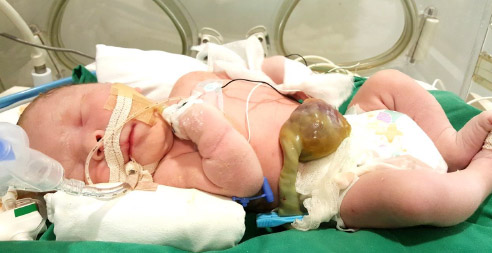Perinatology.
2016 Dec;27(4):260-263. 10.14734/PN.2016.27.4.260.
A Neonate with a PIGA c.1234C>T Mutation as a Novel Cause of Neonatal Early Infantile Epileptic Encephalopathy
- Affiliations
-
- 1Department of Pediatrics, Hanyang University College of Medicine, Seoul, Korea. blesslee77@hanmail.net
- 2Genome Research Center, Green Cross Genome, Yongin-si, Korea.
- KMID: 2367039
- DOI: http://doi.org/10.14734/PN.2016.27.4.260
Abstract
- Multiple congenital anomalies-hypotonia-seizures syndrome-2 is a genetic disorder also known as infantile epileptic encephalopathy. This disorder is associated with a mutation in the PIGA gene, resulting in defective in glycosylphosphatidylinositol biosynthesis. Multiple congenital anomalies-hypotonia-seizures syndrome has variable clinical symptoms; the severity of the congenital anomalies has been reported to be correlated with the loss of PIGA activity. We report a neonatal case of multiple congenital anomalies-hypotonia-seizures syndrome-2 with a PIGA c.1234C>T (p.Arg412*) mutation, which was discovered by exome sequencing and confirmed by Sanger sequencing. The reported patient had omphalocele, facial dysmorphism, neonatal hypotonia, and seizures. To our knowledge, this is the first report in Korea of a neonatal case diagnosed with multiple congenital anomalies-hypotonia-seizures syndrome-2 associated with a germline PIGA c.1234C>T (p.Arg412*) mutation.
Keyword
MeSH Terms
Figure
Reference
-
1. Fauth C, Steindl K, Toutain A, Farrell S, Witsch-Baumgartner M, Karall D, et al. A recurrent germline mutation in the PIGA gene causes Simpson-Golabi-Behmel syndrome type 2. Am J Med Genet A. 2016; 170A:392–402.2. Takeda J, Miyata T, Kawagoe K, Iida Y, Endo Y, Fujita T, et al. Deficiency of the GPI anchor caused by a somatic mutation of the PIG-A gene in paroxysmal nocturnal hemoglobinuria. Cell. 1993; 73:703–711.
Article3. Maydan G, Noyman I, Har-Zahav A, Neriah ZB, Pasmanik-Chor M, Yeheskel A, et al. Multiple congenital anomalies-hypotonia-seizures syndrome is caused by a mutation in PIGN. J Med Genet. 2011; 48:383–389.
Article4. Biesecker LG, Green RC. Diagnostic clinical genome and exome sequencing. N Engl J Med. 2014; 370:2418–2425.
Article5. Johnston JJ, Gropman AL, Sapp JC, Teer JK, Martin JM, Liu CF, et al. The phenotype of a germline mutation in PIGA: the gene somatically mutated in paroxysmal nocturnal hemoglobinuria. Am J Hum Genet. 2012; 90:295–300.6. Kvarnung M, Nilsson D, Lindstrand A, Korenke GC, Chiang SC, Blennow E, et al. A novel intellectual disability syndrome caused by GPI anchor deficiency due to homozygous mutations in PIGT. J Med Genet. 2013; 50:521–528.7. Kinoshita T. Biosynthesis and deficiencies of glycosylphosphatidylinositol. Proc Jpn Acad Ser B Phys Biol Sci. 2014; 90:130–143.
Article8. Belet S, Fieremans N, Yuan X, Van Esch H, Verbeeck J, Ye Z, et al. Early frameshift mutation in PIGA identified in a large XLID family without neonatal lethality. Hum Mutat. 2014; 35:350–355.9. Kim YO, Yang JH, Park C, Kim SK, Kim MK, Shin MG, et al. A novel PIGA mutation in a family with X-linked, early-onset epileptic encephalopathy. Brain Dev. 2016; 38:750–754.10. Swoboda KJ, Margraf RL, Carey JC, Zhou H, Newcomb TM, Coonrod E, et al. A novel germline PIGA mutation in Ferro-Cerebro-Cutaneous syndrome: a neurodegenerative X-linked epileptic encephalopathy with systemic iron-overload. Am J Med Genet A. 2014; 164A:17–28.11. Kato M, Saitsu H, Murakami Y, Kikuchi K, Watanabe S, Iai M, et al. PIGA mutations cause early-onset epileptic encephalopathies and distinctive features. Neurology. 2014; 82:1587–1596.12. Tarailo-Graovac M, Sinclair G, Stockler-Ipsiroglu S, Van Allen M, Rozmus J, Shyr C, et al. The genotypic and phenotypic spectrum of PIGA deficiency. Orphanet J Rare Dis. 2015; 10:23.
Article13. van der Crabben SN, Harakalova M, Brilstra EH, van Berkestijn FM, Hofstede FC, van Vught AJ, et al. Expanding the spectrum of phenotypes associated with germline PIGA mutations: a child with developmental delay, accelerated linear growth, facial dysmorphisms, elevated alkaline phosphatase, and progressive CNS abnormalities. Am J Med Genet A. 2014; 164A:29–35.
- Full Text Links
- Actions
-
Cited
- CITED
-
- Close
- Share
- Similar articles
-
- A case of early infantile epileptic encephalopathy
- De novo HCN1 Mutation Identified by Next-Generation Sequencing in a Patient with Early Infantile Epileptic Encephalopathy: Case Report
- Neonatal Seizures: An Epileptological Point of View
- KCNQ2 Encephalopathy Showing a Distinct Ictal Amplitude-Integrated Electroencephalographic Pattern
- Ketogenic Diet in Infants with Early-Onset Epileptic Encephalopathy and SCN2A Mutation



